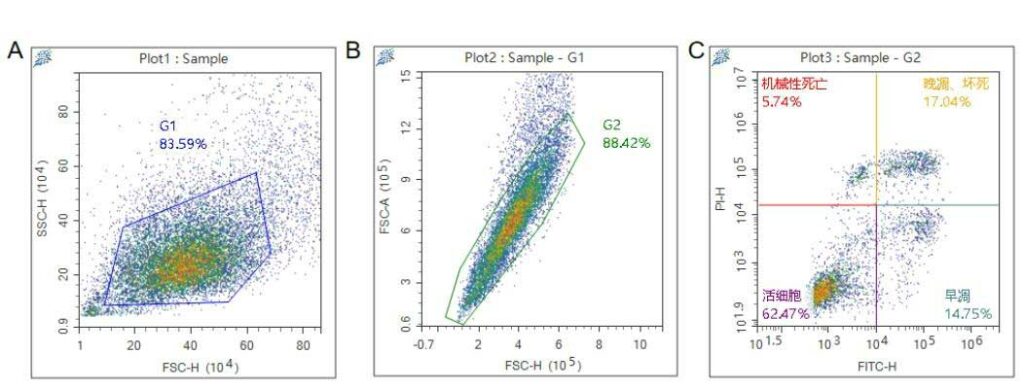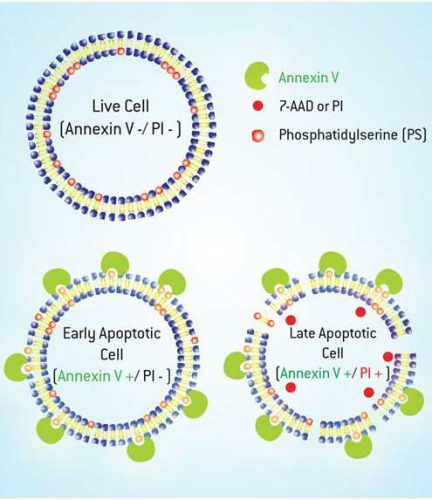
- Home
- Challenbio LongCyte Applications
Applications
Cell cycle detection
Select the linear amplification mode for PI channel, and the cells in the cycle can be divided into G0G1 phase, S phase, and G2M phase based on the signal
strength of the PI. The cells in GOG1 phase have the DNA content of 2N, and those in G2M phase have the DNA content of 4N. Therefore, the closer the ratio of
G2M phase/G0G1 phase MFI approaches 2, the better the staining and detection effect is.


Cell apoptosis detection
AnnexinV can specifically bind to PS on the cell surface. However, due to the phenomenon of PS inversion in early, middle and late apoptosis, as well as necrotic cells, PI or 7-AAD (nucleic acid dye) can be used in combination with the detection process of apoptosis to distinguish early apoptosis from necrotic cells.


Lymphocyte subpopulation detection
TBNK Six Color Panel
After applying the 6-color subpopulation reagent CD3/CD16+56/CD45/CD19/CD4/CD8 to the samples via wash free method, the detection with LongCell flow cytometry will give clear clustering results and absolute counting results.

Treg lymphocyte detection – 9-color
Both International Journal of Laboratory Medicine and Chinese Journal of Health Management have published the clinical consensus on the lymphocyte subpopulation of human peripheral blood. Such consensus states that the detection report of human peripheral blood lymphocyte subpopulation should include the following content: relative and absolute counts (percentage) of CD3+T cells, CD4+T cells, CD8+T cells, B cells, and NK cells, CD4+/CD8+ratio, and the percentage of Treg cells to CD4+T cells.
Liquid phase chip
For applications with very sensitive measurement signal values, such as cytokines and liquid phase chips, their measurement effects are well guaranteed.


CAR-T Positive Cell Identification
CAR-T cells need to undergo strict release testing before being transfused to the patient, and CAR-T cell purity testing is one of the testing items for CAR-T cell quality. Wherein, the CAR positive T cells are effective components that exert tumor killing effects and should mandatorily undergo test for the quality control of CAR-T cell products.

PD-1 immune test for lung cancer
PD-1 is overexpressed on the surface of CD8+T cells in the peripheral blood of tumor patients, and is closely related to the pathological changes and clinical outcome of the patients. The proportions of CD8+PD-1+T cells in the peripheral blood of cancer patients have significantly increased, and the levels of
CD8+PD-1+T cells in advanced patients are higher than those in early cancer patients. This suggests the change of the response level of PD-1 molecules in the peripheral blood CD8+T cells of cancer patients. It is closely related to the progression of the disease in patients.


MSC identification
In 2006, the International Society for Cellular Therapy clarified the identification criteria for mesenchymal stem cells, i.e. meeting all the following conditions:
- adherent growth;
- expression of CD105, CD73, and CD90 (≥ 95% detected with flow cytometry), other than CD45, CD34, CD14 or CD11b, CD79a or CD19,
HLA-DR (≤ 2% detected with flow cytometry) one cell surface; - With stem cell characteristics and able to differentiate into osteoblasts, adipocytes, and
chondrocytes.


Bacteria Detection
Bacterial vitality testing is generally conducted with dead/live dyes such as PI, 7-AAD, primary amines and SYTOX, etc. The range of Challenbio flow cytometer detection is within the range of 0.2 to 50 um, and the beadless absolute counting can be used.

Plant ploidy analysis
The nuclear DNA content and genome size of plants are crucial for studying the biodiversity in multiple research fields of botany. The polyploidization of plant cells (i.e. C value) has important biological significance in the study of the individual growth and development. The detection of plant ploidy with flow cytometry is rapid, accurate, and intuitive. Its application in botany is becoming increasingly widespread. The model organism Arabidopsis plays an indispensable role in botany research, and is widely used in the analysis of plant ploidy.





